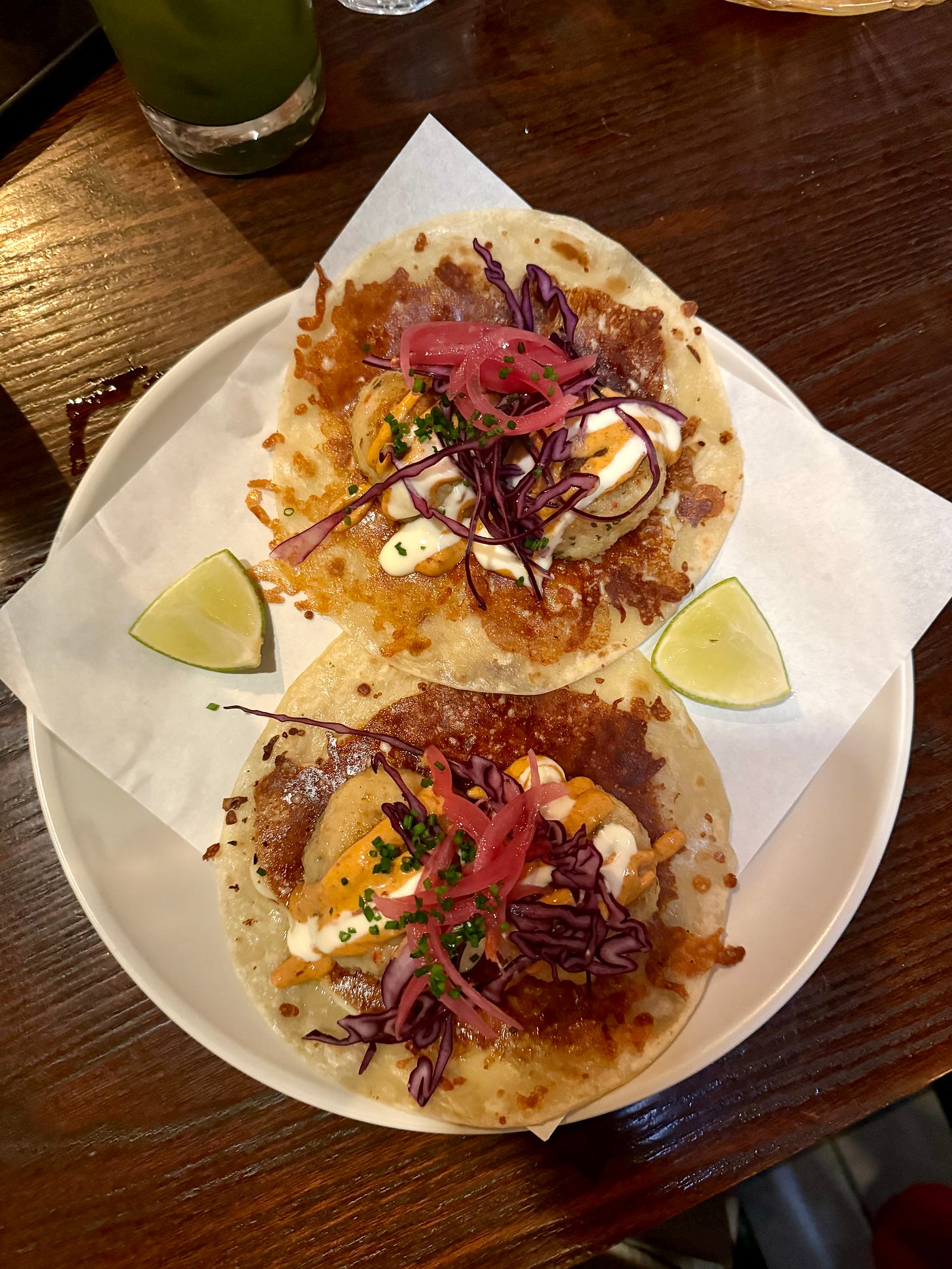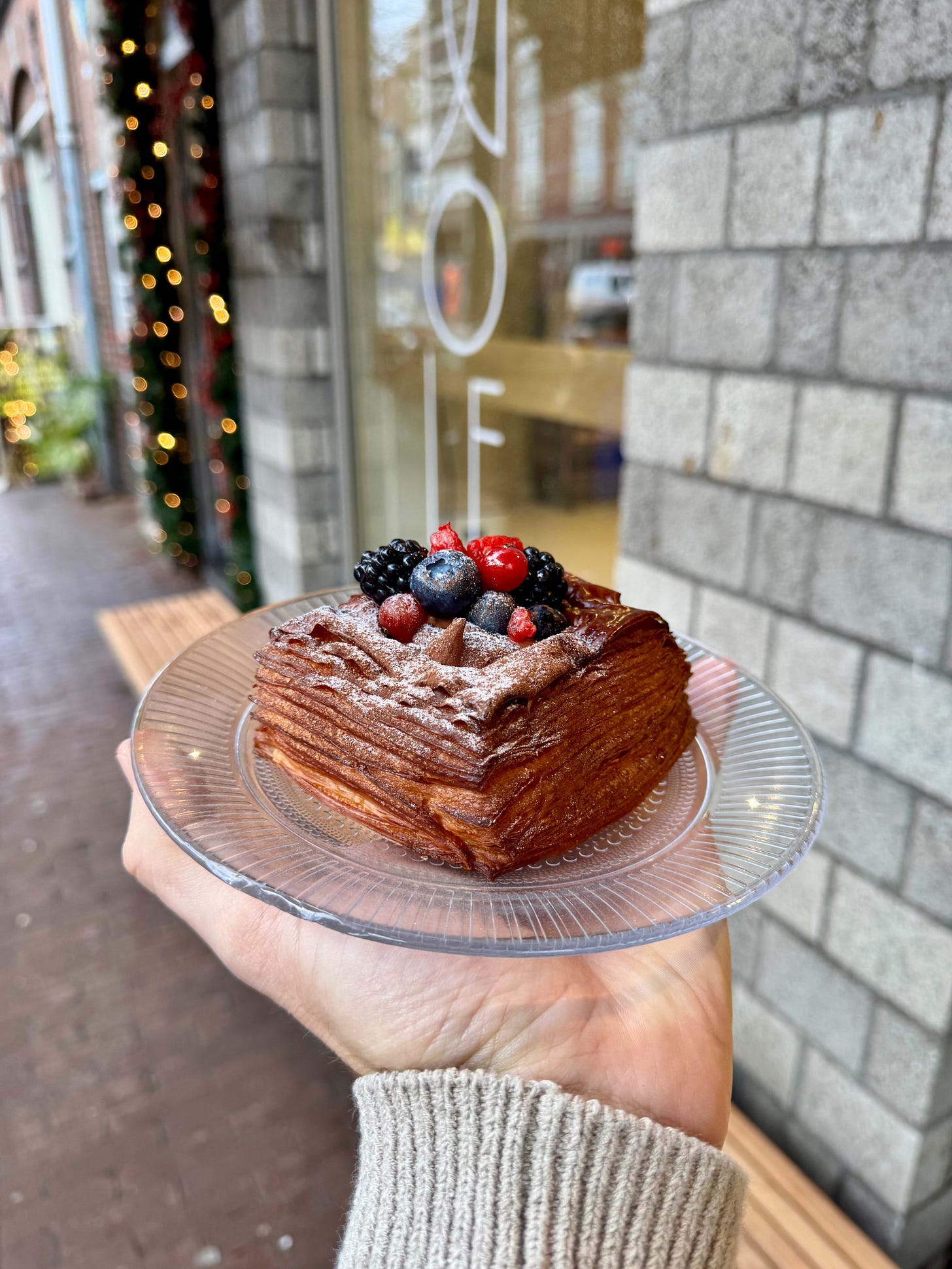I’ve done a lot of eating this year.
There was one sickly day in high summer when I ate two donuts for breakfast, a smash burger for lunch and a curry banquet for dinner. All for the joy of it, of course. Thankfully, my metabolism is faster than a bat flickering past your window. I also never stop moving, which is good, because finding better food often involves the physical act of journeying. You should be cycling the extra kilometre for the croissant that’s butterier than the others.
With all this eating comes thinking (the stomach and the mind are connected after all). It’s fair to say a lot has changed this year in the food scene. For my Word of Mouth series, I’ve been talking to respected food producers about what Amsterdam does and doesn’t do well. I’ve found these conversations so illuminating. So let’s explore where we are in terms of food and what might come next.
Meals don’t exist in vacuums: they arise from, and are in conversation with, pretty much everything from immigration to the climate catastrophe to the algorithmic whims of platforms. Especially TikTok. In 2024, online trends have been bursting to life and dying as fast. While it may be easy to disregard them as noise, in reality, the boundaries between the digital and real world have become wafer-thin. Nearly every food producer has an online presence. Telling the story behind the dish is just as important as the taste. So whatever might be happening online is happening at your table too, even if the chef who cooked your meal claims not to care.
These are my takes on 2024’s biggest trends. They’re obviously a product of who I am and what I like to eat. But I do think they have universality. I’d love to know your thoughts.
Dining
Amsterdam floats in a sea of bakeries. The number is astounding: Fort Negen, Ulmus, Louf, Kometen Brood, Salvo, Bakkerij Solinger, Wolf and Mater… the list goes on and gets longer with brilliant new additions like Farine and Olafbrood. Don’t get me wrong, it’s a baker’s paradise. The quality is exceptional.
But it gives me pause for thought. What’s being pushed out every time another bakery opens? The answer is evening service, which, as I’ve heard time and time again from chefs, is suffering. This city seems a lot less interested in eating dinner than it does popping out for a coffee and croissant. It’s most likely a knock-on effect of both Covid and the cost of living crisis, although I do think there is something particularly miserly about Amsterdammers’ spending habits. It’s outrageous that restaurants like VRR are only half-full on a Friday night.
Daytime rules and the king is the sandwich. I’ve written before about how exhausted I am of the sandwich. Frankly, I’ve seen and tasted it all. But the onslaught continues and I’m sure it will long into 2025. That said, while charging €11 or a sandwich might be jaw-dropping for some, it’s a hell of a lot cheaper than dropping €100 on an evening dinner.
Proper lunch service isn’t booming here either. As I learnt from Jon from Breadwinner and have experienced myself, there isn’t a lunch scene in Amsterdam, not in the same way there is in other cities. I want to be able to go out for a slap-up lunch in a bright, wall-to-ceiling windowed room. I want to devour a caesar salad followed by a minute steak with fries while sinking a gorgeous 0%. I want to lick up a chocolate cremaux and then round everything off with a moody espresso before stumbling into the afternoon. But fulfilling this fantasy is a struggle.
I was recently recommended Turbo, which is on a lot of people’s must-go-to list. When I arrived at lunch, I was disappointed to find out they were only serving… sandwiches. The sandwich was not good. Two slices of bread with a plank of tomato, a limpy lettuce leaf and some turkey ham. When I asked if they made the turkey ham themselves, they said no, they bought it in. A big shame. But this isn’t about one restaurant, more the grab-and-go food lunch culture we increasingly live in.
Even if we’re seeing places close, evening service will, of course, hang on. Go out for dinner and you’ll notice plenty of trends on the menu. Small plates are belligerently still a thing, but there are signs they’re finally dying. Thank god for that. And if it’s not starter, main and dessert that’s mounting a push back, it’s the set menu, which Amsterdam does very well. I’ve had gorgeous five course meals in places like Gertrude, Europizza and Cosmo Tacos. Heaven.
Fishballs have been a big thing on menus this year. I don’t know why, but everyone is whizzing up fish these days. Perhaps it’s about padding out a cheaper cut as a money saver. Whatever, I’m here for it, they’re so bouncy in the mouth. I’ve also seen crudo on every menu from Ferry to Bennies, most often served with a tostada. It’s a fabulous combo, for sure. And then beans are back – I’ve had gorgeous examples of bean dishes, luxurious in taste, at both Esra and Uncommon Bar. It seems the right kind of ingredient for our times: hardy, cheap and good for you.
Baking
In baking, the lipstick effect is real. People have less money, but conversely spend more on better products. Some bakeries enjoy queues the length of the Amstel. If you’re never going to be able to afford a house, you might as well spend your hard-earned euro on a choux bun, right? I say right, because I’d do the same. Life is full of terrible moments, mass-produced croissants don’t have to be one of them.
Some baked goods won’t die. I’m looking at you, hybrid pastries. When will this blight leave us? I can’t really say, I thought we were done with the cruffin and bagnut, but Amsterdam has spawned a truly abysmal example this year: the Crookie, a croissant-cookie, which looks like the failed experiment of a mad scientist in a Marvel movie. Have you tried the Crookie? countless pieces of content ask, generating huge engagement by encouraging outrage. No, I haven’t tried it. Should I? I’m genuinely asking - should I?!
What I have seen that pleases me greatly is far more attention to the bake. This a huge thing in baking: we as bakers want our bread and pastries to be properly caramelised. We want colour and crust. For so many decades, the bake was anaemic, with consumers reaching for weak sunrise-coloured croissants, somehow fearful that anything darker means it’s “burnt.” I’ve seen bakeries all across Amsterdam embrace a much bolder bake, and I love it. This is happening in cookbooks too: one of my favourite baking books, Ravneet Gill’s The Pastry Chef's Guide cranks up the heat on all the bakes. The fruit pies come out so well-done that you can hold them in your hand without risk of breaking.
Online
Food trends hard and fast online. It’s bonkers, really. This year saw everything go chopped on TikTok: smoked salmon bagels got criss-crossed; Italian ham and cheese combos were cut minutely and drowned in dressing before being stuffed between two slices of bread. It was visually appealing, for sure. And I do think there is gastronomic merit to it. In Poland, our vegetable salad is chopped root veg, egg and gherkins mixed into a bath of mayo. It’s pleasing to eat, with each mouthful containing every single ingredient. That’s the beauty of it.
But it went too far. Or too quickly. So amplified was this trend that it burst as quickly as it banged and now no-one – absolutely no-one – is chopping anything anymore. It’s almost mortifying to think about, a little Lord of the Flies how swept up we all got.
Then, of course, we had the cucumber trend that allegedly caused an Icelandic shortage. It started with Logan. If you haven’t seen his shtick, it’s pretty simple: he mandolins an entire cucumber into a pot, dribbles in ingredients, shakes and eats. In a pleasing way, each video is structured identically, from the ooh-er unpeeling of the cucumber to the addition of MSG, which presumably gets all sorts of western knickers in a twist. The views are out of this world: 30M per cucumber video (and there are plenty of iterations). Now he’s doing tofu.
This kind of online blitzkrieg is the real trend of 2024: we simply go mad for one thing, then the next. The pace is ever-increasing. I like to steer clear of pop psychology, but it’s increasingly becoming obvious that long-term use of our phones, in particular social media, has devastated our ability to concentrate, both in the micro and macro sense. We’re simply wired to expect the new. I’ve seen this with my own content: if I post about a just-opened restaurant, it pops. If I cover somewhere a little older, it doesn’t.
I know this might sound a bit grandpa is on one again, but I truly believe that as a society, we’re slowly waking up to the damage of constant phone use. How will this affect food in the future? I’m fascinated to find out.
Effortless home cooking
In 2024, we firmly entered the age of effortless cooking at home. This has already happened in hosting: the days of canapés and cocktails, three courses and after-dinner liquors and petit fours are over. But in terms of regular dinners, we’re trying less too. Perhaps trying is the wrong word: we’re simply throwing ingredients together to fabulous effect.
Ottolenghi, Meera Sodha, Rukmini Iyer and Joe Woodhouse – these cooks show us how to make great food at home in less than 30 minutes or so, without a metre-long list of ingredients. Slow-roasted carrots, a streak of tahini, a bed of herbs, a topping of ripped-up bread, plonked in the middle of the table without a chinois in sight. Gorgey.
I’d argue there’s social capital to this. I listen to people talk about what they cook at home and so often easiness is the quality that they boast about. Oh I just whipped it up. It’s so quick really. The easier it is, the better you are at life because to cook easy means you are nonchalant and unretentive, you can glide in and out of the kitchen in control of your time. This performance makes sense, considering how little control we actually have over our time these days.
A slight knock-on effect of this is that more food is being brought into the home. I see this constantly: bakeries offer bake-at-home versions of their classics (Levain at le vin are doing madeleine kits, cute!), antipasti comes boxed up from a deli and pre-made pies are stacked neatly at the butchers. This is no bad thing. There’s a certain wow factor to being served something beloved from a local neighbourhood shop.
A boom in low to now
This one’s a no brainer: what a year it’s been for non-alcoholic drinks. My shelf is teetering with bold bottles of artisanally brewed things, some fermented, others smoked. They’re beautiful packaged and hefty in hand. There’s real class to them, which feels important, considering the aura that a solid bottle of liquor can have. Just think about booze as a Christmas gift – there’s a symbolic weightiness to it. Now 0% drinks feel the same.
Drinking is down in pretty much every European country. The next generation seem especially unkeen. I don’t think alcohol will go the way of the cigarette but there are startling similarities in their journeys from staple to sin, and it wouldn’t shock me if bottles of alcohol soon carry health warnings with gross pictures of wiry livers.
I’m particularly taken with drinks that don’t attempt imitation. Sparkling teas are not champagne. Fermented beetroot drinks aren’t wine. Herbal kombucha is simply herbal kombucha. This is brilliant because it gives the 0% drinks legitimacy, ridding them of the shadowy label of substitution. I wouldn't be surprised if, soon enough, brands even drop the 0% label. They will simply become… drinks.
The rise of K-foods
Korea is on a never-ending rise, random bouts of martial law aside. K-food is the latest trend to overtake real and digital spaces. This is great news for me, as Korean is probably my number one cuisine. I absolutely love it, from the use of deep fermentation to the life-affirming spice down to the slathering of cheese on rice cakes.
Online, there are a lot of Korean creators doing wonderful things, and I’m not talking mukbang. We have The Korean Vegan, _cookim_, Crazy Korean Cooking – the list goes on. But crucially, they all seem to be in dialogue with one another, pushing the gastronomic form to new heights.
In real life, we’re seeing Korean restaurants pop up everywhere. Barbecue restaurants sizzle and spit while playing K-pop at ear-slamming volume; Korean street food gets served in hissingly hot dishes complete with a layer of bubbling cheese; even the humble bibimbap is being celebrated as an extraordinarily delicious lunch that’s importantly not a sandwich. I’m here for all this.
Gochujang is now a must-have in the kitchen, featuring in everything from Nigella recipes to vegan one-pots. At home, we go through a tub a month. It really does give life to anything. There are still so many Korean sauces for us to try. I’m looking at you, doenjang.
Where next?
Pessimistically, the world is going to become even tougher than it is. The climate catastrophe and regional conflicts will drive up prices of certain goods. This means we’ll be more inclined to spend wisely. We’re all armchair critiques these days too, so we’ll begin to target our eats with much more precision. People will become less forgiving and demand more out of their food.
Optimistically, this will drive up standards. Gone are the days of doing an okay job. Thanks to social media, we’re all in conversation with each other too. This is especially true of baking, where methods and knowledge are shared in the comments section. It pushes every producer to do better. I do think it also engenders community, which is so important in the hospitality industry.
Eastern European food is well due a viral moment. I say that with some bias, but it carries a lot of the same hallmarks as robust cuisines like Korean: filling soups, crispy dumplings, shredded meat, sour fermentation, unapologetic calories… the cooking is often lengthy but not particularly difficult, which gives a sense of satisfaction. Have you tried the viral sauerkraut stew recipe yet? – I can picture it now.
That’s my 2p anyway. I might be wrong about all of this. What do you think?
OK BYE!
If you like what you’re reading, please consider supporting this publication by becoming a paid subscriber. Doing so will help me write stories about food. Alternatively, you can make a one-off donation here. Thank you.











I moved away from Amsterdam last year and I have to say, as a professional baker, I really do miss the quality of bakeries in the city. I’d put the city on par with the likes of Copenhagen and even (gasp!) Paris in terms of innovation and standards. I live in Italy now and it’s pulling teeth trying to get an Italian to eat a cookie that isn’t stale…
Definitely been interested in watching the rise of convenience bakes. I understand why customers are demanding these sorts of products but it seems to take away the experience of both buying a fresh croissant from a bakery, or making your own at home. I keep seeing panettone recipes floating around that promise a bake from rise to table in a day. To me, that takes away the specialness of a panettone. You should devote a lot of time to certain bakes. The goal should not always be to consume, but to create!
Anyway, enjoying your content as usual Tomek. Wishing you and yours a lovely holiday season